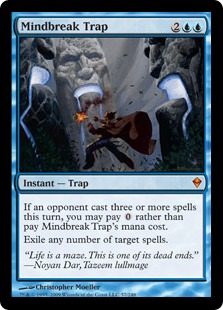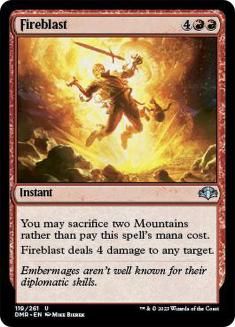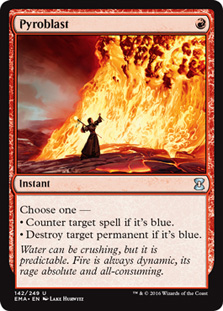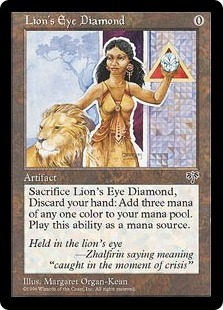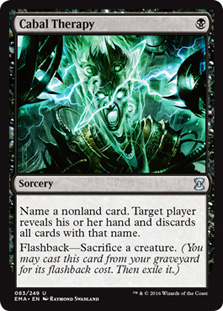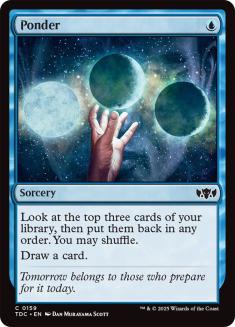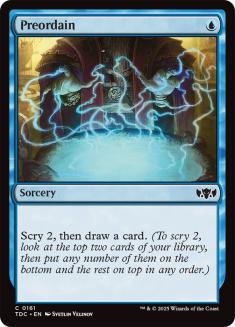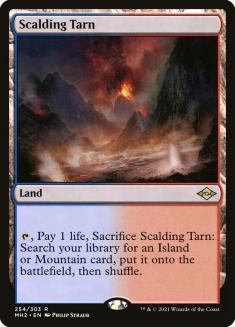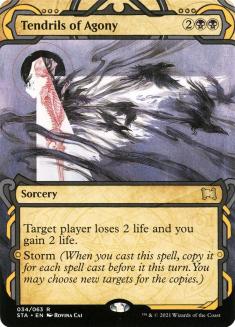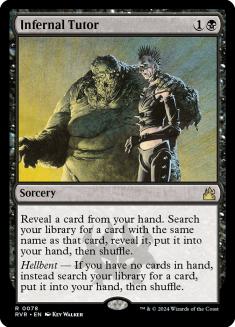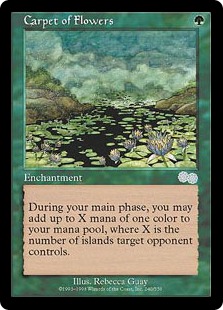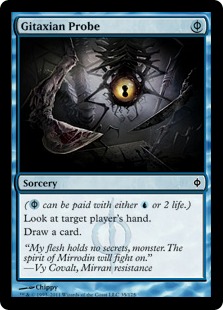One of the big reasons I like Storm so much is its awesome flexibility. The modularity and interlocking nature of its pieces allows you to find wins in the
strangest of situations. It only depends on finding the correct sequence to cast your spells in. It’s hard to learn that skill without actually
experiencing these situations in game, as their modular nature makes them hard to generalize.
One way to exercise this skill without constantly grinding the deck yourself are the rare times we actually get to see Storm on coverage.* Conveniently
enough, there have been at least two Storm players on coverage lately that likely eliminated themselves from contention by having the kill but missing the
line.
Note that I’m not trying to bash these players. I’ve been there. When you’re on Storm, there will be those points in the tournament where you know
there should be a line, but for the life of you, you can’t find it and die. I’ve also sat around with two other Storm players in testing discussing what
might be the right line for at least fifteen minutes before coming to a tentative conclusion, not exactly a luxury you can afford at a tournament. These
things happen. They’re still excellent examples for others to work out what would have been the ideal line in these somewhat tricky cases.
*Storm is always cited as a rare exception during coverage. Yet when one of them makes it to the top 8 rounds, we’re unfailingly put into some game
involving Delvers while Storm is playing on the back table, only scheduled to become the feature match if no other match is still going. Or at least that’s
what it feels like. What’s up with that, Cedric?
Both of them involve some of the more creative uses the deck requires you to make of your cards – but ones that still come up frequently enough to be worth
keeping in mind at all times – so these are already useful case studies to look at just to highlight these little tricks. The fact that they also are
tricky enough to allow me to shed some light on the reasoning and consideration that needs to go into preparing your turns with Storm makes them excellent
examples for teaching about the inner workings of the deck – so that’s why we’ll be looking at these in depth today.
One Line to Rule Them All
The first situation I want to discuss is from game 3 of Rodrigo Togores playing Storm against Jim Davis on burn:
It’s turn 3. Jim has deployed Relic of Progenitus on turn 1, Eidolon of the Great Revel on turn 2, and just suspended a Rift Bolt last turn after attacking
us, keeping up mana for a Relic activation or some form of instant speed spell. He has four cards left in hand at 20 life.
We, on the other hand, are sitting in Rodrigo’s chair. It’s our first main phase, we have a Bayou and an Underground Sea in play and we’ve just drawn our
eighth card, leaving us with a known Tendrils of Agony on top of our library:

There are two questions for you: First, is there a kill here, and if so, should we take it? Second, and I know this helps answer the first question, which
cards can we beat this turn? I’ll give you a moment to consider. Move ahead whenever you feel like you’ve figured out the correct line for this turn.
Wait.
For.
It!
…
Alright, the first thing we need to realize is that we could win with a natural Tendrils here if there were no Eidolon in play. By carefully rereading our
Chain of Vapor, we realize that it can, in fact, serve as an awesome storm engine in situations such as these. Lotus Petal, Lion’s Eye Diamond, Chain of
Vapor using Tropical Island, bounce both of them and recast them (Storm 5), cast double Dark Ritual with Underground Sea, Duress, crack Petal for Ponder
(Storm 9) into Tendrils for 20.
Nice! Our opponent is dead barring that Eidolon and relevant cards in their hand. Chain is meant to handle Eidolon, so that’s what we’ll want to use to do
that. However, that’s where the first complication comes in. We need to play Lion’s Eye Diamond and Lotus Petal before we play the Chain to get to a high
enough Storm count. That means we’re already taking at least six damage this turn.
Suddenly our opponent’s options seem a lot more relevant. Time to figure out if we should try to win this turn. We’re definitely down to 10 next
turn from the Rift Bolt and the Eidolon (either through an attack or the trigger). That means any two three-damage burn spells plus Fireblast kill us, and
our opponent just missed a land drop. I wouldn’t want to risk it if I could avoid it.
The counterpoint would be Mindbreak Trap, which we’ve seen in game 2. Actually, it’s time to figure out which cards are even relevant to take into
consideration this turn. The main things that matter to us that our opponent might have here are:
We’ll want to play around as many combinations of these as possible. So let’s set up the easy limits on that:
– To win through Mindbreak Trap, we need to Duress at some point, likely before our third spell so that we don’t get interrupted on accident.
– To beat Lightning Bolt, we need to stay at 4 life or above; for Fireblast alone, we need 5; and for both, we need 8.
– To win through Pyroblast, we need to Duress before casting Chain of Vapor as it either protects Eidolon or stops the Ponder. That means we would need to
take at least 8 damage from Eidolon, putting us to 7 life.
At this point, it’s clear we aren’t beating all of these being in hand. So how can we beat the maximum? Well, first we could decide to just lose to
Mindbreak Trap or Pyroblast. If the opponent has neither, just going for the drop artifacts, bounce them, and Eidolon line wins the game at 9 life, safely
out of the range of any combination of burn spells not involving Gut Shot or Simian Spirit Guide. The real question then becomes can we win through more?
The easiest way to find out is to try to win through everything and see where that takes us. The condition on Mindbreak Trap already suggests we need to
cast the Duress before getting rid of the Eidolon unless we cast Chain of Vapor before our third spell, which doesn’t leave us with enough Storm.
Pyroblast puts additional pressure on us to cast Duress before Chain of Vapor, so that’s what we’ll try to do. We also have additional reason to cast it as
early as possible to have the ability to adapt out plans in response to the new information provided by either possible responses or seeing their hand. If
we get hit with Bolt plus Fireblast in response, for example, that creates two Storm so we might be able to minimize our life loss to Eidolon by skipping
on the bounce-trick with Chain of Vapor.
So looking at our mana, we have access to any combination of blue and black mana we might need other than triple black. We definitely need two blue mana
for the Chain and the Ponder, so we’re left with exactly one black mana to work with. That means we can’t start the turn off with a Duress, we need to cast
a Ritual first. So we imagine doing that (Storm count is 1, 13 life, BBB), next we cast Duress (Storm 2, 11 life). Now comes the complicated part.
What Happens if…
– If they have Pyroblast/Mindbreak Trap and Lightning Bolt plus Fireblast and just don’t cast anything ever, we’re dead. If they have a combination of
Traps and Pyroblasts, we’re dead. So we ignore these scenarios. Luckily, they’re rather specific, and I don’t think they’re worth risking death from just a
couple of burn spells next turn.
– If they have Trap/Pyroblast and a Fireblast, can we win (Storm count is 2, we’re at 11 life)? I’d think about this one first, as it includes just
Lightning Bolt, saving time. Assuming that is Jim’s hand, we take the counter, drop our artifacts (Storm 4, 7 life), cast Chain of Vapor (Storm 5, 5 life),
and from there on out we can win just out of range. Nice.
Alright, so there’s an alternative line to winning through Bolt plus Fireblast here that beats Trap but loses to Bolt plus Blast. Time to make a read. Or
is it?
– If our opponent has only Lightning Bolt plus Fireblast in hand, what happens? They either respond to the Duress with these burn spells (Storm is 4, 4
life) – at that point, we can move onto the Chain of Vapor-Eidolon line – or they don’t respond and we take the Fireblast. At that point, we win, once
again, comfortably at 5 life. If they only respond with one of the burn spells (say Fireblast, as that does more damage), we can still take the other and
adapt by playing only one artifact before chaining (from Storm 3, 7 life).
Pretty good, so we have a line that beats a counter plus Fireblast and Bolt. The only remaining concern are additional copies of Lightning Bolt and
Fireblast, which the very first line obviously beats.
– If they have a second Fireblast, we only care if they respond with the Bolt (as we can take that otherwise and win at 5 life). If they respond, we can
Chain the Eidolon directly (Storm 4, 6 life), play both artifacts (Storm 6), the second Ritual (Storm 7), and Ponder into Tendrils (Storm 9) when they’re
at 18 life due to their own Eidolon. Alright, so extra Fireblasts don’t matter.
– What if there are extra Lightning Bolts they held back? If they have double Bolt and Fireblast, they need to respond with Fireblast (Storm 3, 7 life), as
otherwise we can move back onto the win on 5 life line. If they do, we don’t get to take anything of relevance with Duress. We need to Chain right there to
not die to the Bolt (Storm 4, 5 life), followed by Ritual, and the two artifacts into Ponder (Storm 8). One Storm short.
It seems that in that case, we would have to get lucky and hit another cantrip or Infernal Tutor in our top 3 in addition to the Tendrils instead of
straight up taking it with Ponder (we can crack Lion’s Eye Diamond for blue to open up the opportunity of casting the extra cantrip).
There is also a different line we could use against double Bolt, Fireblast: If we feel like putting it all on a jedi mind trick instead of the two
top cards of our deck. To Fireblast, they need to sacrifice their Mountains so they need to float red mana first if they want to still cast the Lightning
Bolt. If they haven’t changed the rules without me noticing, that means that we can also calmly announce that we’d like to move to our second main phase,
clearing the mana pools. If they bite and fire off their Bolt – which might be in their interest since that means Eidolon plus Rift Bolt are lethal next
turn even without them drawing mana, and if not, they should at least be tempted to crack the Relic now that it won’t do anything relevant anymore – we
remain inside our first main phase and they take two from Eidolon (Storm 4, 4 life) or leave us at 7 life by cracking the Relic. We’ve already established
that those are winning positions.
If they don’t bite, however, we lose access to black mana and can’t go off any more this turn. We’ll also draw a very hurtful Tendrils next turn (hurtful
because we can’t let it hit the graveyard with Relic in play and we have LED in hand). So we’re likely forced into meekly bouncing the Eidolon (5 life) and
having to pray they don’t draw a Mountain to complement the Rift Bolt and Lightning Bolt in their hand before we can go off through those new constraints.
That means we have a line that can beat all but one multiple burn spell scenarios (and still retains a decent shot in that one in two different ways) and
can also win through a single hate card. Sounds worthwhile compared to passing against a Burn player that could easily deal 10 next turn or simply draw
another Eidolon, especially given that our graveyard is off due to Relic.
In the end, I’d definitely decide to go for it and hope to fade the couple of hands I can’t beat (against those that don’t contain double disruption, we
also lose by saying go) going with the convoluted Chain of Vapor line because I’m reasonably sure a single hate card is more likely than Fireblast double
Bolt. As it turns out, Jim had exactly the two Lightning Bolts and the Fireblast that would have made that line a sweat, and sadly, we don’t know what
those other two cards on top of his library would have been. While it’s obviously anecdotal evidence, it would be nice to have closure on that kind of
question, I feel.
Worthy of note: Jim had no disruption in hand, so going with the straightforward Lotus Petal, Lion’s Eye Diamond, Chain of Vapor to start with line would
have locked this game up for sure. If you can trust your read enough, that’s definitely something to consider. I mean, he did have turn 1 Relic of
Progenitus, turn 2 Eidolon of the Great Revel. How much more hate would he need to keep that hand?
The Failed Ad Nauseam
Another situation that pops up with some regularity when you’re playing ANT is that of the (seemingly) failed Ad Nauseam. That usually happens when you hit
a ton of discard spells and cantrips but not enough free mana. However, there are a couple of things to keep in mind when judging your Ad Nauseam, and the
game we’ll take a look at is a convenient place to show off a couple of them.
One such situation happened last week in the deciding game of the semifinals of SCG Oakland between Randolph Gille on Storm and Jimmy Dela Cruz on Sultai
Delver:
Our Delver opponent has had a very slow start, deploying a Grafdigger’s Cage but no clock to speak of until a turn 3 Deathrite Shaman on the play. We, on
the other hand, have untapped for turn 4 now – Deathrite Shaman is active but unused – cast Brainstorm, followed by Tropical Island into Duress, taking a
Spell Pierce from our opponent’s hand and leaving them with just a Stifle and a Misty Rainforest. We then tapped our Underground Sea to chain Dark Ritual
into double Cabal Ritual (the second of which our opponent has allowed to go off with threshold for some reason) and hardcast Ad Nauseam with two black
mana floating and a storm count of 6. We start flipping at twenty life:

I’ll now list the cards in the order we flip them. If you want to learn the most possible from this exercise, go along and analyze your options after every
flip. Once you decide our opponent is dead, stop flipping and execute your kill to make sure it actually works. Randolph lost this game after what I’d call
a typical storm-induced brainfart. Would something similar have happened to you?
Ad Nauseam Flips:
Alright, take your time and figure out what our line is, I’ll be waiting with my answer slightly further down the page.
Wait.
For.
It!
…
This is a pretty unlucky set of flips. We’ve hit the Lion’s Eye Diamond and the Infernal Tutor to put the game away, but sadly, we’ve also hit the Tendrils
of Agony so we can’t go for that against Deathrite Shaman and Grafdigger’s Cage. At the same time, our deck has also refused to find that single piece of
additional mana acceleration we’d need to simply hardcast the Tendrils from hand. Basically, we’re a little short whichever way we look at it. Or are we?
Clearly if I’m asking this, there is a kill to find here, and the only question is if we need all of these cards to execute it. This scenario is also a lot
easier to solve than the first one because we’re playing with perfect information, meaning we can avoid the whole session of “what if?”
One of the things I want to highlight here is how annoying drawing (into) your Tendrils is against Deathrite Shaman decks. Once Shaman is active, having
the Tendrils in hand, we suddenly can’t use one of the deck’s core interactions anymore (Infernal Tutor plus Lion’s Eye Diamond) because that would lead to
Tendrils getting exiled.
There are two ways to get around this. The first one is the obvious one: win without using Lion’s Eye Diamond for mana. The second one is also reasonably
obvious, as it’s the classic solution to any problem involving cards in your hand that you want in your deck. Find a Brainstorm and put it where you want
it.
If you needed the hint, that’s where Randolph should have stopped. If he intentionally went further even after realizing he had won, don’t copy him. There
are a number of players with the habit to just keep flipping until they reach a dangerous life total. Don’t do that. You should be thinking about your
lines while flipping. You want to know what you need before ever turning over the next card. In my experience, it’s just much too easy to miss something
otherwise, and sometimes an extra flip can destroy a lethal line just by being in your hand.
Randolph should have realized the Brainstorm solves his issues and stopped. How do we get to the kill to work afterwards then? Well, it all works because
of how Carpet of Flowers is worded. It triggers at the beginning of each of your main phases, and you can use it once per turn to add mana. That means we
can play the Carpet in the first main phase, move through combat and profit from the trigger on this very turn. That would give us two black mana to work
with now and another six mana – including LED, however, so hardcasting Tendrils is out of the question – to work with in the second main phase.
So how do we win using this neat little Brainstorm interaction? Well, our plan clearly has to involve casting another discard spell, as the Stifle will
counter our Storm trigger otherwise. We have mana floating now and clearly no way to generate enough mana without Carpet to cast the Tendrils, so using
that black mana to cast the Cabal Therapy we’ve flipped seems advisable. We also need to deploy the Carpet of Flowers right now, as otherwise it won’t
trigger so that occupies our Tropical Island – our only green source.
We do those things (Storm 8, B floating) and now realize we don’t have anything else to do with our floating mana so we pass to the second main phase and
trigger Carpet. We now need to get blue mana, as our plan involves casting Brainstorm and we don’t have another blue source. So we add UUU to our mana pool
and cast Brainstorm, draw three irrelevant cards and put back anything but the Lion’s Eye Diamond under the Tendrils of Agony.
The rest is easy, if you know your LED tricks. We play LED and cast any one of the other cantrips we’ve flipped with Ad Nauseam, hold priority and
sacrifice Lion’s Eye Diamond for BBB in response. We now have UBBB floating and a known Tendrils of Agony as the top card of our library with a cantrip on
the stack that will draw us into it, a Storm count of 10 already pre-Tendrils, and an opponent with nothing but a fetchland in hand.
Once we’ve figured all of this out, we declare that we’ve done enough Ad Nauseaming this game and execute this line without any need for further thought.
That wasn’t so hard, was it?
Observations Made
These were only two turns in two games we’ve analyzed here, and that has already taken more than 3500 words to cover, so that should leave you with a solid
impression as to how deep games of Magic can be sometimes. It should also be ample proof that I’m not joking when I claim that half the games I lose with
Storm involve some stupid mistake on my part while my deck had given me the tools to get there only for me to throw things away. These losses just come
with the highly modular nature of the deck, and all we can do as Storm players is to minimize them as much as possible.
The best way I’ve found to do this is to commit as many interactions and regular lines as possible to muscle memory, that is to say having used them often
enough and gone through enough “kill turns” to make them second nature, taking it into account essentially subconsciously before you ever start thinking
about what you might need to do to win. The fewer things that come up regularly you have to think about, the more brainpower you have left over to make the
contextual decisions.
For everybody not interested in playing Storm, I hope this was still at least interesting from an opponent’s point of view and should at the very least be
concrete proof of how important the information war is in matchups involving Storm. Simply knowing Jim’s hand in the first game makes that turn from
something where we have to think incredibly hard to find the one sequence of spells that gets around most possible options into a straight up kill line
without any chance for Jim to interact meaningfully. There is a huge decision tree linked to the Storm player not knowing what he’s facing exactly, and
that whole decision tree and all the complications it introduces simply vanish once perfect information is achieved.
Finally, if you liked this and would like to see more articles where I deconstruct gamestates in detail, feel free to share particularly interesting ones
you’ve encountered. Who knows, one of those might make it into a future article!


